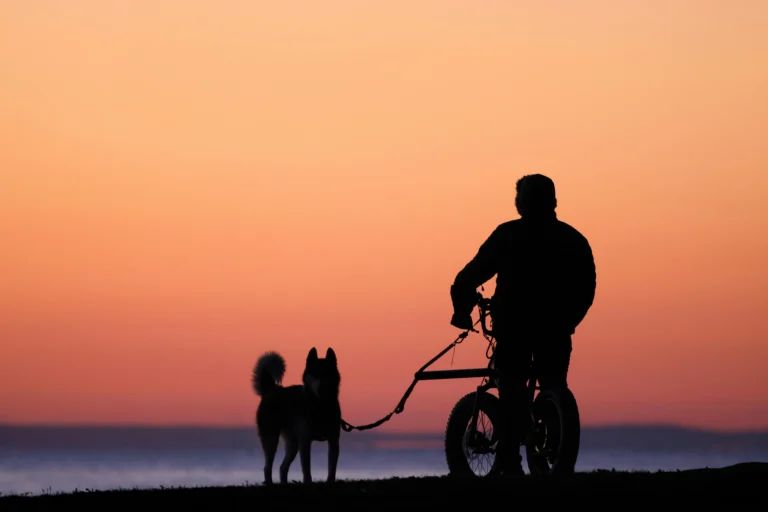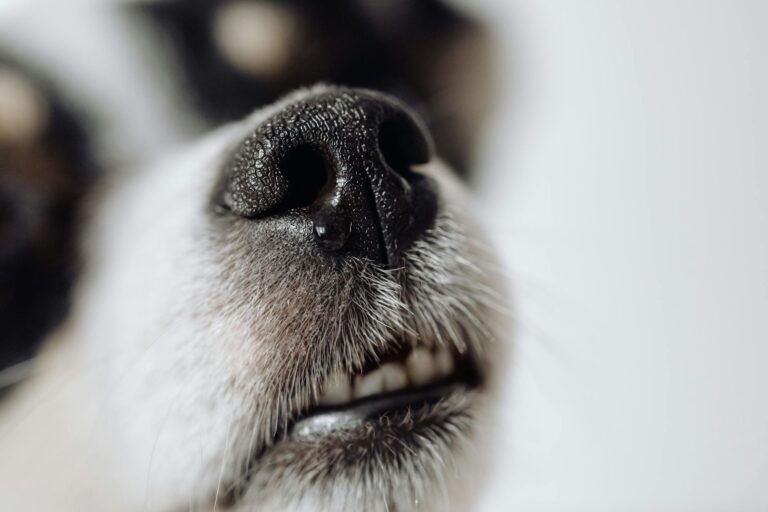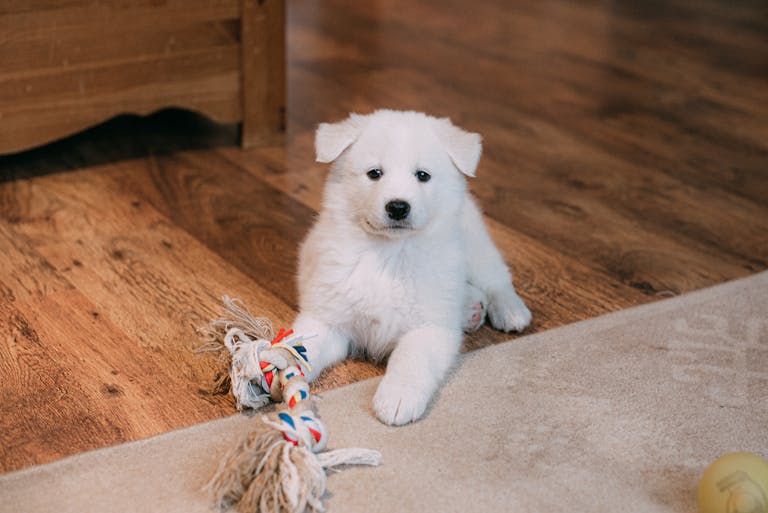How to Teach a Dog to Play

Think your dog doesn’t like to play? You might just need the right approach. Here’s how to get started.
You did all the work. You bought the basket of toys before your dog even arrived. But now that they’re here… nothing. Maybe a sniff. A glance. Then back to bed like it never happened.
It’s easy to feel disappointed or confused—but here’s the good news: this is totally normal.
Many dogs, especially rescues, undersocialized pups, seniors, or shy breeds, don’t instinctively know how to play. The instinct is there—they just need help unlocking it. And with time, consistency, and some gentle encouragement, even the most reluctant pups can learn to love play.
Why Play Matters
Before we dive into how to teach your dog to play, it helps to understand why play is such an important part of a dog’s life—even if they don’t naturally engage with toys yet.
Mental Stimulation
Play isn’t just physical—it’s problem-solving. Whether your dog is chasing a ball, tugging a rope, or figuring out how to get a treat out of a toy, they’re thinking through each step. That mental engagement is surprisingly tiring—in the best way.
For high-energy or anxious dogs, this kind of focused activity can help settle the brain and body.
Physical Exercise
Of course, play gets your dog moving. A game of fetch or tug adds an extra layer of physical activity that walks alone can’t always meet. It’s not a replacement for structured exercise—but it’s an excellent supplement that keeps bodies loose and muscles working.
Bonding & Trust
Dogs don’t play unless they feel safe. So when your dog does initiate or engage in play, that’s a huge sign of emotional trust. For shy or fearful pups, even a short game can help build confidence and deepen your relationship.
Training Reward
Some dogs are toy-driven more than treat-driven. Once your dog understands play, you can use a quick tug session or ball toss as a reward during training. It’s a great way to keep sessions fun and engaging.
Emotional Healing
For rescue dogs or dogs with difficult pasts, play can be transformative. It’s a gentle, joyful way to rewrite negative associations with humans. Over time, play helps your dog learn that people can be fun, safe, and worth engaging with.
Bottom line? Play is more than just a way to pass time—it’s a tool for enrichment, healing, and connection.
Step-by-Step: How to Get Your Dog to Play
Before anything else, take a deep breath—and release any pressure to “make” your dog play. Your job at this stage is simply to create opportunities for exploration, without forcing interaction.
Step 1. Start Slow – No Expectations
Set the Scene
Scatter a few different types of toys in a calm, familiar space. Try a mix of:
- Plush toys
- Rubber or silicone toys
- Tug ropes
- Squeaky toys
- Soft balls
Place them passively—don’t wiggle them or wave them around yet. Let your dog discover them on their own terms.
Watch for Interest
You’re looking for tiny signs of curiosity, like:
- A glance
- A sniff
- A paw tap
- A nose nudge
When you see one, mark it (say “Yes!” or “Good!”, or use a clicker if you have one) and calmly reward with a treat, praise, or even space to disengage. You’re showing your dog: “That interest? That was awesome.”
Keep Sessions Short
Early on, it’s important that toys feel like a special opportunity, not just background clutter. Limit play sessions to around 10 minutes max, even if your dog doesn’t seem engaged yet.
When the time’s up, calmly put the toys away. This helps build anticipation—so when the toys come out again, they feel new, exciting, and worth investigating.
And remember: Resist the urge to overdo it. No waving toys in their face or exaggerated “let’s play!” voices just yet—right now, too much enthusiasm can feel more like pressure than fun.
Step 2. Pair Toys with Positives
If your dog doesn’t see the point of toys yet, it’s time to make them worth caring about. The goal here is to connect toys with things your dog already loves—like food, safety, and comfort.
Make Toys Smell Delicious
- Rub a bit of peanut butter or soft cheese on a toy.
- Sprinkle treat dust (crumbled freeze-dried treats or kibble) onto plush or rope toys.
- Tuck small treats inside Kongs, puzzle balls, or even beneath toys on the floor
Let your dog “discover” the goodies. You’re helping them form a connection: Toy = good things happen.
Place Toys Where They Feel Safe
- Try leaving toys in cozy areas: near their bed, crate, or favorite chill spot.
- Avoid tossing toys into new or high-traffic areas—they’re more likely to be ignored.
The more relaxed your dog feels around the toy, the more likely they are to engage with it.
Over time, you should begin to notice your dog taking an interest in certain toys. For example, my rescue developed an obsession with Kongs almost overnight. That’s when we escalate to the next step.
Step 3. Gently Get Involved
Once your dog starts showing interest in toys—sniffing, nudging, or carrying them—it’s time to step in just a little. You’re not trying to lead the play yet, just to join the conversation.
Be Present, Not Pushy
- Sit near your dog with a toy in hand, relaxed and nonchalant.
- Wiggle a toy slowly on the floor—don’t wave it in their face.
- Roll a ball past them, not at them. Let them decide whether to follow.
Avoid hovering, looming, or sudden movements. Keep your posture soft and open.
Use Calm, Playful Signals
- Light claps or soft laughter
- Gentle “ooh!” or playful eyebrow raises
- Big smiles and relaxed body language
The goal is to be inviting, not overwhelming. Your energy should say: “This is fun, if you want to join me.”
Avoid high-pitched squealing, chasing, or jumping in early stages. It might work with a confident puppy—but for a hesitant dog, it can feel confusing or even threatening.
Step 4. Turn Play into a Game
Once your dog is exploring toys and comfortable with your gentle involvement, it’s time to take the next step: make it a game. Games add structure, purpose, and movement to play—which helps spark instinct and curiosity.
Not every dog will love every game, so experiment. The goal is to find what clicks.
Try These Easy Starter Games
- Flirt Pole Fun
Great for prey-driven or energetic dogs. Move the toy in slow circles at first, then build speed as confidence grows. - Find-It Games
Hide treats with or inside toys. Start easy—let your dog watch you hide it—then build up to full “seek and sniff” sessions. - Chase Me
Hold a soft toy or towel on a string and gently drag it a few feet away. Let your dog chase without pressure to catch or tug. - Back-and-Forth Recall
With a partner, sit on opposite sides of the room. Call your dog between you and reward with a treat or short play. - Gentle Tug
Use a long fabric strip or soft toy. Let them “win” often. Keep your grip loose and movements light to avoid overwhelming them.
Start small. Even a 10-second game counts. Over time, you can build longer, more active sessions based on your dog’s comfort and preferences.
Shape the Behavior
If your dog is starting to interact with toys—even a little—you can now begin to shape that behavior into something more playful and consistent.
This is where a clicker or marker word (like “Yes!” or “Good!”) becomes really helpful. You’re reinforcing small steps toward full-on play, one moment at a time.
Use Simple Shaping Cues
Here’s how to turn curiosity into confidence:
| Behavior | What You Do |
|---|---|
| Looks at toy | Mark and treat |
| Sniffs or noses toy | Mark and treat |
| Touches with paw | Mark and treat |
| Picks it up or mouths it | Jackpot (extra praise/treats!) |
| Brings it toward you | Start a short game |
| Drops it near you | Praise + toss or reset |
Keep your sessions short and your expectations low. You’re not asking for perfect fetch—you’re rewarding interest that leads to fun.
Encourage, Don’t Command
Avoid saying “fetch,” “play,” or “go get it” too early. You want the behavior to feel natural, not pressured.
Let your dog offer the behavior first, then reinforce the heck out of it.
Think of this stage like planting seeds—you’re reinforcing the actions you want to grow into reliable play.
Teaching the Rules of Play
Once your dog is engaging more consistently, it’s time to add structure. Rules aren’t about limiting fun—they’re what make fun feel safe and predictable.
Dogs thrive on clarity. Setting simple boundaries around play helps prevent overexcitement, confusion, and accidental nips or frustration.
Introduce Key Cues
Start teaching a few play-related cues early. These build control into the fun, so things don’t spiral.
- “Take it” – Gives your dog permission to grab the toy.
- “Drop it” – Ends the game or swaps the toy for a reward.
- “Come” – Use for reset moments or fetch-style games.
- “That’s enough” / “All done” – Gently signals that playtime is over.
Keep these cues short, upbeat, and consistent.
Keep Sessions Short and Positive
Always end on a high note—before your dog gets overwhelmed or bored. Think: “success ends the session,” not “we keep going until it stops being fun.”
3–5 minute bursts are plenty at first. You can build duration as your dog gets more confident and eager.
Avoid Confusing Games
Skip roughhousing or ambiguous games like “keep away” or “chase me” unless you’re using them very intentionally (e.g. to build confidence in a shy dog).
Play should feel safe and clear—not like a puzzle your dog has to decode.
Final Thoughts
You’re not just teaching your dog to play—you’re teaching them that play is safe, that you are safe, and that joy is allowed.
Some dogs leap into toy baskets without hesitation. Others need time, patience, and a lot of gentle encouragement before they’ll even sniff a plush. Both are normal.
Whether your dog was undersocialized, fearful, or just unsure, play is a skill that can be learned. And once it clicks, even just a little? You’ll have a happier, more well-adjusted pet.




